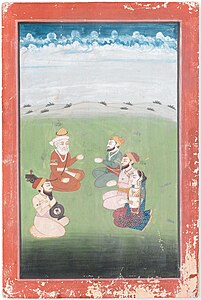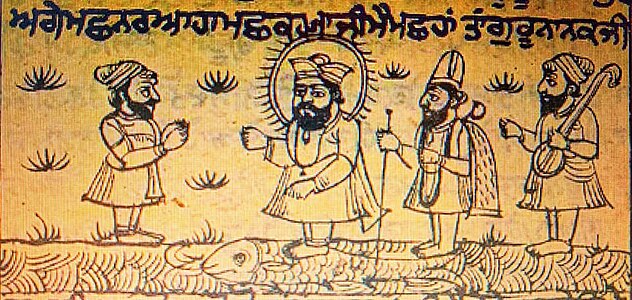Nanakpanthi[1] (Gurmukhi: ਨਾਨਕਪੰਥੀ; nānakapathī, "follower of the way of life of Nanak"),[2] also known as Nanakshahi,[3] is a Sikh sect which follows Guru Nanak (1469-1539), the founder of Sikhism.[3][4]
 Photograph of a Nanakpanthi by J. L. Lyell, ca. 1860s | |
| Total population | |
|---|---|
| Unknown | |
| Founder | |
| Guru Nanak | |
| Regions with significant populations | |
Punjab • Sindh | |
| Religions | |
| Sikhism • Hinduism | |
| Scriptures | |
| Guru Granth Sahib • Janamsakhis |
History
The term was first used in the Janamsakhis of the Miharvan tradition,[5] and was later mentioned in the mid-17th-century Dabistan-i-Mazahib.[5]
Description
Nanakpanthi references an early Sikh community which encourages any person, regardless of religious affiliation, to follow Guru Nanak's teachings of universal brotherhood, truth, love, tolerance, and compassion. It emphasizes the oneness of Waheguru (the creator of the universe).[6]
Distribution
Today, some Sindhis and Punjabis adhere to elements of Sikhism despite being Hindus.[7][8] They generally do not have beards or wear a turban, unlike Amritdhari Sikhs.[9] There is no data about the number of Nanakpanthis.
Worldwide, there are estimated 25 to 30 million Sikhs.[10][11] Millions of others also venerate the 10 Sikh gurus and follow the teachings of Guru Granth Sahib.[A][12]
A number of ethnic groups and sects in India follow the teachings of Guru Nanak and visit gurudwaras, in addition to worshiping Hindu deities at mandirs. The Indian government considers them Hindus for census purposes.[13] A number of ethnic Punjabis who are Hindu, especially in Indian and Pakistani Punjab, Delhi, Haryana, Rajasthan, Chandigarh, Jammu and Uttarakhand, have continued other religious practices in spiritual kinship with Sikhism.[14]Nanakpanthi, as a label referring to the selective, personal following of Guru Nanak to the exclusion of his successors, was criticized by mainstream Sikh writers such as Bhai Gurdas.[5]
Punjabi Muslims
Cultural anthropologist Haroon Khalid wrote that after the partition of India, a few Muslims regularly visited Guru Nanak's shrine in Kartapur Sahib and made offerings; they continued to do so despite the shrine's dilapidated condition and its harboring of smugglers and drug addicts.[15] Descendants of Bhai Mardana, a Muslim companion of Guru Nanak, reportedly follow a syncretic tradition of Sikhism and Islam. Mardana's descendants performed kirtans in gurdwaras before the partition.[16][17]
Sindh
Sikhism was popularized in Sindh by the missionary work of Udasi saints.[18] Nanakpanthi and Udasi are both Sikh sects; a major difference is that Udasis adopt life-long celibacy, whilst Nanakpanthis marry and have children.[19] Sikhs from the Punjab may have settled in Sindh during the 16th century to escape persecution, and they and their descendants gradually formed the basis of the Nanakpanthi community.[20] Guru Nanak reportedly traveled through Sindh, reaching the Shikarpur area and impacting local spirituality.[2] In the 1881 and 1891 Indian censuses, the Sindhi Hindu community could not decide to identify as Hindu or Sikh.[21][page needed] Many Sindhi Nanakpanthis migrated to India during the 1947 partition, and are found in the states of Maharashtra, Gujarat, and Rajasthan.[2]
Many Sindhi Hindus in India and Pakistan admire Guru Nanak and regularly visit gurudwaras.[22][23] A Sindhi temple typically houses the Guru Granth Sahib and images of Hindu deities.[24]
Places of worship
A Nanakpanthi temple is known as a tikano or tikana (a term also used for Sewapanthi temples).[25][26][19] They are prevalent in Sindh,[27][19] where religious syncretism of Hinduism and Sikhism is observed and religious boundaries become blurry and ill-defined.[28][29][30] A tikana usually houses a copy of the Guru Granth Sahib alongside images of Indic deities.[29][19]
Gallery
- Guru Nanak and Bhai Mardana with three devotees, from a series of Janamsakhi paintings
- A Nanakpanthi, ca. 1825
- Sketch of a Nanakpanthi
- 18th- or 19th-century Nanakpanthi depiction of Guru Nanak and Bhai Mardana
- Guru Nanak riding a fish. 19th-century art, possibly from Sindh




